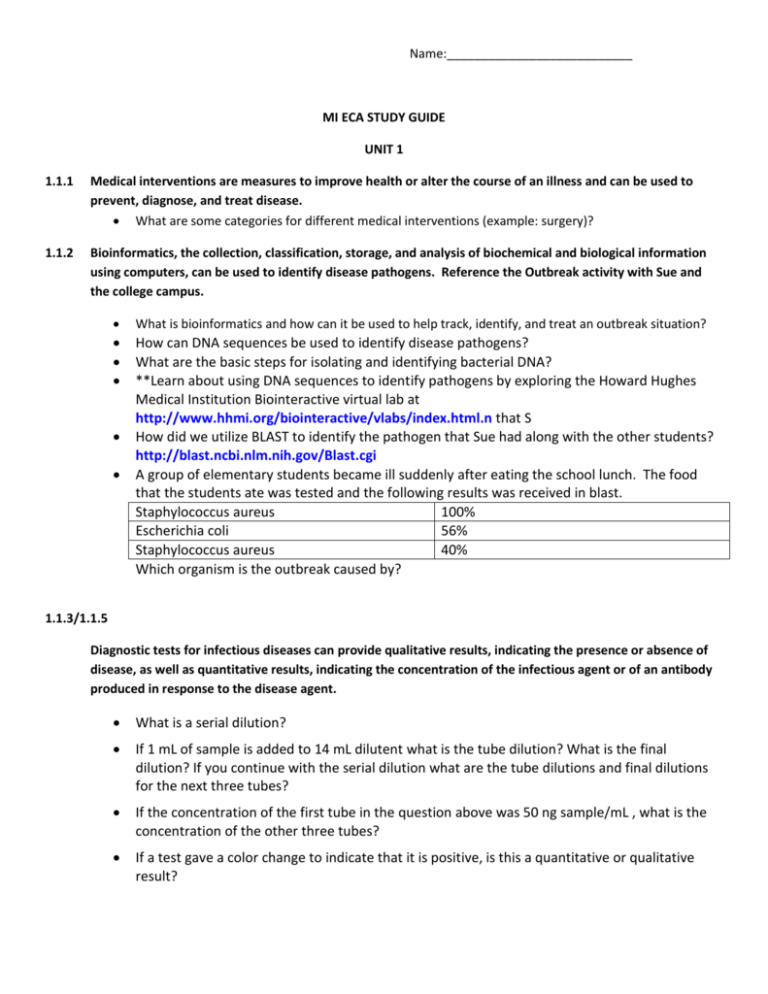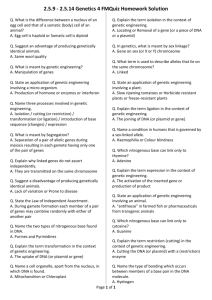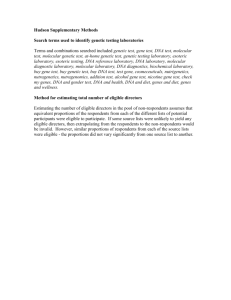Name: MI ECA STUDY GUIDE UNIT 1 1.1.1 Medical interventions
advertisement

Name:___________________________ MI ECA STUDY GUIDE UNIT 1 1.1.1 Medical interventions are measures to improve health or alter the course of an illness and can be used to prevent, diagnose, and treat disease. What are some categories for different medical interventions (example: surgery)? 1.1.2 Bioinformatics, the collection, classification, storage, and analysis of biochemical and biological information using computers, can be used to identify disease pathogens. Reference the Outbreak activity with Sue and the college campus. What is bioinformatics and how can it be used to help track, identify, and treat an outbreak situation? How can DNA sequences be used to identify disease pathogens? What are the basic steps for isolating and identifying bacterial DNA? **Learn about using DNA sequences to identify pathogens by exploring the Howard Hughes Medical Institution Biointeractive virtual lab at http://www.hhmi.org/biointeractive/vlabs/index.html.n that S How did we utilize BLAST to identify the pathogen that Sue had along with the other students? http://blast.ncbi.nlm.nih.gov/Blast.cgi A group of elementary students became ill suddenly after eating the school lunch. The food that the students ate was tested and the following results was received in blast. Staphylococcus aureus 100% Escherichia coli 56% Staphylococcus aureus 40% Which organism is the outbreak caused by? 1.1.3/1.1.5 Diagnostic tests for infectious diseases can provide qualitative results, indicating the presence or absence of disease, as well as quantitative results, indicating the concentration of the infectious agent or of an antibody produced in response to the disease agent. What is a serial dilution? If 1 mL of sample is added to 14 mL dilutent what is the tube dilution? What is the final dilution? If you continue with the serial dilution what are the tube dilutions and final dilutions for the next three tubes? If the concentration of the first tube in the question above was 50 ng sample/mL , what is the concentration of the other three tubes? If a test gave a color change to indicate that it is positive, is this a quantitative or qualitative result? Name:___________________________ 1.1.5 1.2.1 Antibody-based diagnostic tests, such as the ELISA assay, utilize fundamentals of human immune response to detect the presence of disease. Write a paragraph explaining the ELISA assay. Use the following words in your paragraph: antigen, Primary antibody, Secondary antibody, Enzyme, Substrate, Neisseria meningitidis bacteria. Why is the secondary antibody used in an ELISA test conjugated with an enzyme? What happens when this enzyme meets up with its substrate? How can an ELISA assay be a quantitative and qualitative test? Why is it important for a doctor to know the concentration of disease antigen present in a patients system? Antibiotics disrupt the pathways that bacteria use to survive. 1.2.2 What is the mode of action for the following classes of antibiotics: Penicillins (also called βLactam antibiotics), Tetracyclines, Fluoroquinolones, Sulfa antibiotics (Sulfonamids) For each class of antibiotic above, indicate where and how the antibiotic affects the bacterial cell. What are the parts of a bacterial cell? Some parts are labeled for you. Bacterial cells use multiple pathways to gain resistance to antibiotics. How do bacteria use plasmids to gain antibiotic resistance? How did we use a plasmid in this lab? Name:___________________________ 1.2.2 Overuse and misuse of antibiotics will promote the selection of resistant bacteria. http://www.fda.gov/AnimalVeterinary/SafetyHealth/AntimicrobialResistance/ucm134359.htm. Use the website above to view the following sections that provide information about the mechanisms of antibiotic resistance. Note: antibiotics are referred to as antimicrobials throughout the animation. Mutation, Destruction or Inactivation, Efflux 1.3.1 1.3.2 Use the website above to view the following sections that provide information about gene transfer between bacterial cells: Conjugation, Transformation, Transduction. Problems with one or more structures within the ear cause various types of hearing loss. What is the difference between sensorineural hearing loss and conductive hearing loss? Do you know the parts of the ear? Which structures of the ear are affected/damaged if someone has sensorineural hearing loss? Conductive hearing loss? There are a variety of interventions available to help people with hearing loss. What are some interventions available for people with hearing loss? How do these interventions help with hearing loss? 1.4.1/1.4.2 Vaccines are medical interventions that activate the immune system to recognize a disease antigen and produce antibodies necessary to defend the body. http://health.howstuffworks.com/vaccine.htm 1.4.2 Use the website above to learn about how vaccines work. What are the different types of vaccines and how do they work to activate the immune system? Plasmids can be employed as an important tool in genetic engineering and can serve as vectors, vehicles for the movement of genetic information. What is a plasmid? What are the two “tools” of molecular biology often referred to as scissors and glue? Explain how these two “tools” are used to create a plasmid. Explain why a plasmid and a segment of DNA to be inserted into a plasmid must be cut with the same restriction enzyme. Use the term sticky ends in your response. Name:___________________________ UNIT 2 2.1.1/2.1.2 Genetic testing is the use of molecular methods to determine if someone has a genetic disorder, will develop one, or is a carrier of a genetic illness and involves sampling a person’s DNA and examining the chromosomes or genes for abnormalities. What is genetic testing? Describe the following types of genetic disorders and give a speicific example. Single Gene – recessive, Single gene – dominant, Single Gene – sexlinked, Multifactorial, Chromosomal, Mitochondrial Compare and contrast preimplantation genetic diagnosis and fetal testing. Does one type of test raise more ethical concerns than the other? Explain your thinking. What is IVF? 2.1.1 Genetic counseling can help a family understand the risks of having a child with a genetic disorder, the medical facts about an already diagnosed condition, and other information necessary for a person or a couple to make decisions suitable to their cultural, religious and moral beliefs. 2.1.2 The polymerase chain reaction (PCR) is a laboratory procedure that produces multiple copies of a specific DNA sequence. Describe PCR. What is the goal of PCR? What are the three main steps in the PCR process? At what temperature does each step occur? 2.2.1 How would a genetic counselor use a pedigree to help his or her clients understand genetic diseases? Explain why parents may be fearful or apprehensive about genetic testing. What are the duties of a genetic counselor? What can a genetic counselor do/not do in regards to advice to a couple seeking reproductive help? Based on what you know about the process of PCR, what reagents must have been included in the PCR bead you used in the experiment? Explain. How can you tell (when looking at a gel) that a certain band of DNA has gone through more cycles of PCR? Gene therapy is a type of disease treatment in which faulty genes are replaced by functional copies. http://learn.genetics.utah.edu/content/tech/genetherapy/ and read the three sections listed below. What is Gene Therapy? Choosing Targets for Gene Therapy. Gene Delivery: The Key to Gene Therapy. What are the advantages and disadvantages of using viral vectors for gene therapy? What factors must be considered when choosing a vector for a gene therapy trial? Name:___________________________ UNIT 3 3.1.3 Cancer is a term used for more than 100 different diseases in which cell regulation genes are mutated causing the cells to reproduce out of control. Describe the process where normal cells become cancer cells. What is the difference between an oncogene and a protoncogene? What are some differences between normal cells and cancerous cells when they are grown in vitro? If you were inspecting tissue taken from a tumor biopsy, what characteristics would you look for that would indicate the presence of cancer cells? Describe three distinct morphological differences you would expect to see between normal cells and cancer cells. 3.1.2 X-rays, CT scans, and MRI scans are used to create pictures of the inside of the body to diagnose and treat many disorders. 3.1.4 What is the difference between X-Rays, CT scans and MRI? Explain how they work and what they are used to diagnose. DNA microarrays measure the amount of mRNA for genes that is present in a cell sample. DNA microarrays show a level of expression of _____________. a. DNA b. mRNA c. tRNA d. DNA polymerase Describe the steps in a DNA microarray. What is the goal of DNA microarray? 3.1.4/3.1.5 Scientists use DNA microarray technology to determine the differences in gene expression between different tissue samples. 3.2.1 What does it tell us if two genes show the same levels of expression in cancer cells and normal cells? What does it tell us if there are some genes that are highly expressed in normal cells but not expressed in cancer cells? Behavioral, biological, environmental, and genetic risk factors increase the chance that a person will develop cancer. 3.2.3 What are specific examples of each of the following risk factors? Behavioral, biological, environmental, and genetic. Molecular diagnostic tests, such as marker analysis, can be used to detect inherited genetic mutations associated with certain cancers and can be used to predict risk for developing those cancers. Name:___________________________ Describe the process of marker analysis. How is marker analysis used to detect genetic mutations? Draw a diagram showing how marker analysis works. 3.2.4 Viruses insert their DNA or RNA into a host cell, causing the host cell’s genes to mutate which can sometimes cause the cell to become cancerous. What three viruses are linked to causing cancer? What cancers are linked to these viruses? How does a virus cause cancer? a. capsid of virus is absorbed into human genome b. virus injects DNA that is at a coding region of a gene c. virus injects DNA that in a non-coding region of host DNA d. virus injects DNA in a coding and a non-coding region of host DNA 3.2.5 Routine cancer screenings can prevent certain types of cancer or can increase the chance that cancer is detected at an early stage when treatment is more effective. 3.3.2 3.3.3 Biofeedback therapy is a technique in which patients are trained to improve their health or manage pain by learning to control certain internal bodily processes that normally occur involuntarily, such as heart rate, respiration rate, and skin temperature. Describe biofeedback therapy. What are some examples of things you can do that are considered biofeedback therapy? When going through a stressful situation what happens to your respiration rate, heart rate and skin temperature? What can biofeedback therapy due to help with the stressful situation? What are some different strategies that can be used by patients during biofeedback therapy? Advances in technology are allowing the development of artificial limbs that look and move more like actual human limbs. 3.4.1 What are some routine cancer screenings males and females should have done throughout their lifetime? Describe a myoelectric arm. How does this type of prosthetic help look and move like actual human limbs? SNPs can cause changes in enzymes that metabolize certain drugs in the body. http://learn.genetics.utah.edu/content/health/pharma/. 3.4.3 Use the website above to answer the following questions: What is a SNP? What is a haplotype? How can you use SNP profiles to make choices in drug treatments? What is pharmagenetics? How can it be used by doctors to help make treatment decisions for patients? How does the study of SNPs and bioinformatics open the door to the development of personalized medications? Clinical trials are regulated by strict guidelines that ensure data collected is valid and human subjects are treated ethically. What factors need to be taken into consideration when deciding whether or not to participate in a clinical trial? Name:___________________________ Controlled, randomized, double-blind studies are considered the gold standard for clinical trials. Explain the terms: controlled, randomized, and double-blind. Why are these so important to the accuracy of a clinical trial? A clinical trial is conducted and neither the researcher or the participant knows if he/she is receiving the drug. What type of trial is this? 3.4.4 Why have the strict guidelines been put in place for human subjects? What has happened in history? Nanomedicine shows great promise, particularly for cancer research, in the hope that medical interventions can be developed at the cellular and molecular scale to diagnose and treat disease. Describe different types of nanomedicine/nanotechnology that can be use to treat cancer. How does each type of nanomedicine/nanotechnology work? What are some negative to using nanomedicine at this time? UNIT 4 4.1.2 Recombinant DNA technology allows scientists to custom-design bacteria that can produce a variety of important protein products, including insulin. 4.1.2 4.1.3 Why are bacteria a good choice for producing many copies of a particular gene in a short period of time? How are restriction enzymes and ligase utilized in recombinant DNA technology? Explain why it is necessary to use the same restriction enzyme to cut the desired gene from the source and to cut the plasmid. Include a drawing or diagram in your answer How can we produce insulin using bacteria and plasmids? Plasmids, rings of DNA containing genes of interest, can be inserted into bacteria cells via the process of bacterial transformation. Explain the role of arabinose in the bacterial transformation experiment. How do the heat shock and the calcium chloride assist plasmid insertion in this chemical transformation? Relate your answer to the charge on DNA and to the charge on the plasma membrane of a cell. Explain the steps in the bacterial transformation process. Be specific Chromatography is a technique used to separate components of a mixture and can be used to separate proteins based on the properties of their side chains. GFP contains a large number of hydrophobic amino acids. Describe how these amino acids would be oriented in the protein. How do you think the chemical properties of GFP can be used to isolate this protein from others in a mixture? How does amino acid structure relate to the overall shape of a protein? What is chromatography? Name:___________________________ How can chromatography be used to separate proteins How was GFP isolated from other proteins found in the bacterial cell? a. by size – large protein from small proteins b. by shape of the protein c. by hydrophilic interactions in the column d. by dydrophobic interactions in the column. 4.2.1 When the kidneys are not functioning properly, they will not filter adequately and harmful wastes products such as urea, creatinine and blood urea nitrogen build up in the blood stream and the body will make fewer red blood cells because of the lack of the hormone erythropoietin. A patient had their blood drawn and the following test results were obtained: Test: Blood Urea Nitrogen Levels Blood Creatine Levels Blood Potassium Levels Red Blood Cell Count Glomerular Filtration Rate (GFR) Urinalysis Blood Pressure EKG 4.2.1 4.3.2 60 mg/dL 2.8 mg/dL 7.1 mEq/L 3.6 million cells/mcL 13 mL/min Presence of red blood cells Presence of white blood cells High levels of albumin (300 mg/dL) 140/90 Normal What diagnosis is most likely for this patient? How is ESRD diagnosed? What is the treatment for ESRD? Normal 8-24 mg/dL .6 -1.2 mg/dL 3.7 -5.2 mEq/L 4.2 – 5.4 million 30 mL/min or above None None Less than 150 mg/dL 120/80 normal Dialysis is an artificial process that removes waste products and excess water from the blood when the kidneys can no longer function. 4.3.1 Result(s): What is the difference between perotineal dialysis and hemodialysis? What are the pros and cons of using each type? Deciding who receives donated organs is not always a clear-cut issue and involves many difficult decisions guided by federal policies. What is the NOTA? What are some policies set up by the NOTA? What is the OPTN? What are some policies set up by the OPTN? For the best chance of a successful organ transplant, the donor’s and recipient’s tissue types need to match as closely as possible. Why is HLA typing necessary when matching up a kidney donor and recipient? How is HLA determined for donor and recipient? Name:___________________________ 4.3.5 What is meant by PRA and why is a lower number better for a kidney recipient? Why could a person reject a pig valve? The various members of a surgical transplant team work together to make sure the transplant is a success. 4.4.1 4.4.1 Who are the four biomedical professionals that make up the transplant team? What role is the role of each professional in a success transplant? A variety of tissues and organs can be transplanted from one organism to another. What parts of the human body can be replaced? Which organs or tissues in the human body can normally heal or regenerate? Which organs or tissues can be damaged beyond repair? There are benefits and risks of using xenotransplantation and tissue engineering for organ and tissue replacements. o What are the benefits and risks of using xenotransplantation and tissue engineering for replacement organs? o What are the ethical considerations for xenotransplantation and tissue engineering? Make sure you know the difference between: a. Transduction b. Transformation c. Conjugation d. Transposition









